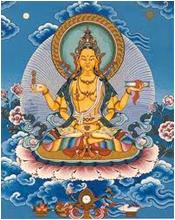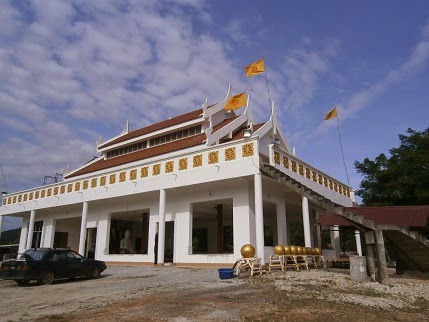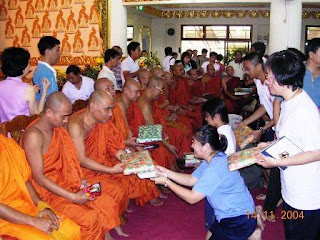The Three Levels Of Refuge
If there is a threat, we should seek refuge from it. Similarly in the context of spiritual practice, to protect ourselves from the threat of an unfavourable rebirth, we should seek refuge in the Three Jewels: Buddha, Dharma and Sangha.
Buddhism teaches three different levels of refuge. The first is where we seek protection from the immediate threat of the suffering of rebirth in a lower realm of existence. Inspired by the greater fear that this possibility evokes, we seek refuge in the Three Jewels in order to avoid it. This level of refuge is relevant to initial scope of practitioners, whose goal is to attain an upper rebirth.
When we think of the lower realms of existence, we should not think of some place far away in the distant future. All that actually lies between the present moment and the next life is simply the continuity of our breath. The moment we stop breathing, when we breathe out an don't breathe in, the next life is right there in front of us.
It is not a matter of distant time in the future, it is immediate. In order to bring about a concordant sense of urgency, therefore it is necessary for us to reflect upon impermanence, particularly upon inevitably of death, the uncertainty of the time of death and what will benefit us when death arrives.
The second level of refuge is where we seek protection from the suffering of pervasive conditioning; the suffering of being caught in cyclic existence and the destructive power of the negative thoughts and emotions. In order to overcome such sufferings, we take refuge in Buddha, Dharma and Sangha which embody the total transcendence of suffering and cyclic existence, particularly the suffering of pervasive conditioning. This level of refuge is relevant to middling scope of practitioners, whose goal is to attain nirvana.
The third and highest level of refuge is that of the Mahayana practitioner. Here, we seek refuge from the extremes of samsaric existence on the one hand and individual liberation on the other. In order to be protected from these two extremes, we seek the attainment of Buddhahood, Dharmakaya and Rupakaya, for the benefit of all sentient beings.
When we view refuge in this way, we can understand the significance of Maitreya's statement that the true and ultimate refuge is Buddha alone, because only an enlightened being embodies all this perfection. Maitreya goes on to say that the Buddha's enlightened mind encompasses the ultimate jewel of Dharma and also represents the ultimate perfection of the jewel of Sangha.
Buddhism teaches three different levels of refuge. The first is where we seek protection from the immediate threat of the suffering of rebirth in a lower realm of existence. Inspired by the greater fear that this possibility evokes, we seek refuge in the Three Jewels in order to avoid it. This level of refuge is relevant to initial scope of practitioners, whose goal is to attain an upper rebirth.
When we think of the lower realms of existence, we should not think of some place far away in the distant future. All that actually lies between the present moment and the next life is simply the continuity of our breath. The moment we stop breathing, when we breathe out an don't breathe in, the next life is right there in front of us.
It is not a matter of distant time in the future, it is immediate. In order to bring about a concordant sense of urgency, therefore it is necessary for us to reflect upon impermanence, particularly upon inevitably of death, the uncertainty of the time of death and what will benefit us when death arrives.
The second level of refuge is where we seek protection from the suffering of pervasive conditioning; the suffering of being caught in cyclic existence and the destructive power of the negative thoughts and emotions. In order to overcome such sufferings, we take refuge in Buddha, Dharma and Sangha which embody the total transcendence of suffering and cyclic existence, particularly the suffering of pervasive conditioning. This level of refuge is relevant to middling scope of practitioners, whose goal is to attain nirvana.
The third and highest level of refuge is that of the Mahayana practitioner. Here, we seek refuge from the extremes of samsaric existence on the one hand and individual liberation on the other. In order to be protected from these two extremes, we seek the attainment of Buddhahood, Dharmakaya and Rupakaya, for the benefit of all sentient beings.
When we view refuge in this way, we can understand the significance of Maitreya's statement that the true and ultimate refuge is Buddha alone, because only an enlightened being embodies all this perfection. Maitreya goes on to say that the Buddha's enlightened mind encompasses the ultimate jewel of Dharma and also represents the ultimate perfection of the jewel of Sangha.




Comments